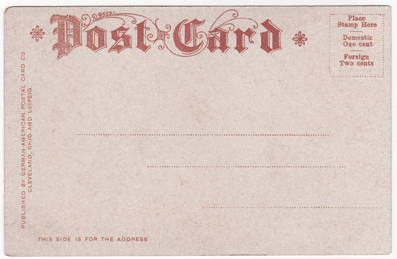A Technique for Age Dating Vintage Postcards
Determining an old postcard’s date of printing, or when it was made, can be a complicated process – especially if the vintage postcard was never mailed. The only way to really find the age of a postcard is to compare the back of the postcard to the known facts of postcard history and the front of a picture postcard to the history of its subject.
American vintage postcard history can be illustrated by some age dating techniques and other facts about the publishing of postcards during the early 1900s in the United States.
Our collection of postcards come from the late 1800s to early 1900s. This is an interesting time in postcard history. In order to date each card, we can often use the postal mark with date as a guide, but some cards do not contain this date stamp. In these cases we are on a treasure hunt, viewing historic pictures of the towns, reading history, and trying to determine the age of the card from old images of the town and the markings on the card. For instance, the postcard shown here of Pittsburgh, PA is determined to be circa 1902 – 1907, while the actual picture must be from the 1800s.
This was determined by fact that the use of the word “POST CARD” or “POSTCARD” (as one or two words) was granted by the government to private printers on Dec. 24, 1901. Before that, only the U.S. Post Office could issue them. Writing was still not permitted on the address side. This is why postcards from this time period or earlier often have the printing on the front across the picture. During this time, postcards had an undivided address side, with horizontal lines running across. This example card from Pittsburgh had a back as shown below:

The “divided back” card, with space for a message on the address side, came into use in the United States in 1907. So our card must have been printed between 1902 and 1907. The “divided back” era is considered by many to be the “Golden Age” of postcard history because senders were now able write on the back of postcards leaving the front images intact. And because postcards from this point in history were still created with a great deal of care.
Now, by viewing the History of Bridges and Tunnels of Allegheny County, we can see that this picture shows the 1877 Point Bridge across The Monongahela River to the right of The Point (where the Ohio, Allegheny, and Monongahela Rivers meet) and the Union Bridge across the Allegheny River to the left of it. The 1915 Manchester Bridge had not been built yet. Notice the boats on the river and the train on the bridge. By looking at other historic pictures of Pittsburgh, we find that these types of trains and boats can be viewed crossing the rivers in pictures around 1900. But the skyline of Pittsburgh changes dramatically from 1900 to the first World War in 1917, so by viewing dated images of downtown Pittsburgh, we find that drawing on this postcard is quite old, as the large red building near The Point is not in any of the pictures that we found from the 1900s.
Another clue to this postcard’s history comes from the spelling of Pittsburgh on the card. Pittsburgh is one of the few American cities to be spelled with an “h” at the end of a burg suffix. This style is commonly used for many other cities and towns of western Pennsylvania. While briefly referred to as “Pittsburg” during the late 19th century, the Pittsburgh spelling was officially restored in 1911 after a public campaign by the citizens of the city. Therefore, the picture on the card may be a drawing from the 1800s made into a lithograph, while the card itself is 1902 – 1907.